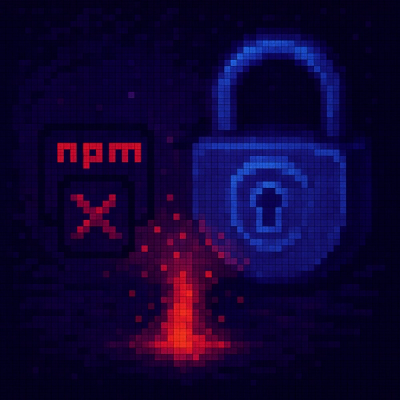
Security News
Software Engineering Daily Podcast: Feross on AI, Open Source, and Supply Chain Risk
Socket CEO Feross Aboukhadijeh joins Software Engineering Daily to discuss modern software supply chain attacks and rising AI-driven security risks.
rollup-plugin-visualizer
Advanced tools
[](https://npmjs.org/package/rollup-plugin-visualizer) [](https://github.com/btd
Visualize and analyze your Rollup bundle to see which modules are taking up space.

npm install --save-dev rollup-plugin-visualizer
or via yarn:
yarn add --dev rollup-plugin-visualizer
Import
// es
import { visualizer } from "rollup-plugin-visualizer";
// or
// cjs
const { visualizer } = require("rollup-plugin-visualizer");
Usage with rollup (rollup.config.js)
module.exports = {
plugins: [
// put it last
visualizer(),
],
};
Usage with rolldown (rolldown.config.ts)
import { defineConfig, type RolldownPlugin } from 'rolldown';
export default defineConfig({
plugins: [
visualizer() as RolldownPlugin
],
})
Usage with vite (vite.config.js)
module.exports = {
plugins: [visualizer()],
};
Usage with vite TypeScript (vite.config.ts)
import { defineConfig, type PluginOption } from "vite";
export default defineConfig({
plugins: [visualizer() as PluginOption],
});
Usage with SvelteKit (vite.config.js)
const config = {
plugins: [
visualizer({
emitFile: true,
filename: "stats.html",
}),
],
};
export default config;
You will find 2/3 files in .svelte-kit/output dir named stats.html (see vite logs for file locations) . You can use this snippet as a starting point and change props/path. You can also generate 3 json files and combine them to one with cli util.
Blue color used to to mark project-own files. This could be: written by you files or generated by build tool files.
Green color used to mark your dependencies.
Internally it just checks if file id prefix is node_modules.
All charts refresh layout on window resize.
This circular hierarchical diagram can help you find huge pieces of code (aka that one huge thing). If you click on some arc it will increase its and all nested arcs size for better inspection.
This diagram is top down version of sunburst. It is used a lot by other JS developer tools and would be very familar to developers.
This rectangular hierarchical diagram can help you find huge pieces. Just look on biggest rectangle. But also it can help you find modules included several times, they will have the same topology and relative size. If you click on rectangle it will increase in size for further inspection.
This diagram should help you answer for the question 'why it is included?'. After force layout stabilize all nodes, you can move it back and forth by dragging with your mouse. Gray circles are treeshaken out files.
In real life scenarios, sometimes you will see terribly connected diagrams. There is no 100% working solution for everyone, it is expected you topology will look 'terrible' and not hold on screen. To make it still visually inspectable, first remove all highly connected nodes that you see (typical examples: commonjsHelpers, tslib, react etc, basically if tooltip for the node is not hold on the screen - exclude this node), after layout stabilization you will see, your layout is not that terrible anymore and most of dependencies cluster together. Move layout to find pieces you looked for.
When you click on node it will highlight nodes that are listed in tooltip (the files that imports current node).
This template produce JSON output with raw data. Normally it should be used with CLI from this plugin.
Output yml file with all the data, could be good idea to commit this file to track file changes.
filename (string, default stats.{ext depending template}) - name of the file with diagram to generate
title (string, default Rollup Visualizer) - title tag value
open (boolean, default false) - Open generated file in default user agent
template (string, default treemap) - Which diagram type to use: sunburst, treemap, network, raw-data, list, flamegraph.
gzipSize (boolean, default false) - Collect gzip size from source code and display it at chart.
brotliSize (boolean, default false) - Collect brotli size from source code and display it at chart.
emitFile (boolean, default false) - Use rollup's emitFile to generate file. Useful if you want to control all output in one place (via rollup output options). This also could be useful with svelte as it calls vite several times.
sourcemap (boolean, default false) - Use sourcemaps to calculate sizes (e.g. after UglifyJs or Terser). Always add plugin as last option.
projectRoot (string | RegExp, default process.cwd()) - This is some common root(s) path to your files. This is used to cut absolute files paths out.
include (Filter | Filter[], default undefined) - Filter for inclusion
exclude (Filter | Filter[], default undefined) - Filter for exclusion
Filter type is { bundle?: picomatchPattern, file?: picomatchPattern }
Note about include and exclude - If options.include is omitted or has zero length, filter will return true by default. Otherwise, an ID must match one or more of the picomatch patterns, and must not match any of the options.exclude patterns. This entries will not be included in stats at all.
Include and exclude filters uses glob matchers with picomatch. In UI you can do such combinations (both exclude and include):
translation-*.js:*/**/index.js - this selects all bundles that matches translation-*.js and all the files by all paths that name is index.js. : is separator and required only when bundle search used.BUNDLE_GLOB:FILE_GLOBFILE_GLOB part (empty string)*/**/index.js - select all files that name is index.jsThis plugin provides cli util rollup-plugin-visualizer. Add --help to check actual options. It can be used like:
rollup-plugin-visualizer [OPTIONS] stat1.json stat2.json ../stat3.json
This can be useful in case you have different config files in the same project and you want to display all of them in the same chart.
For development if you need to build plugin, just exec:
npm run build
Generated html files do not and never will contain your source code (contents of files). They can contain only js/html/css code required to build chart (plugin code) and statistical information about your source code.
This statistical information can contain:
See CHANGELOG.md.
network, treemap, sunburst, flamegraph can change does not matter of version (colors, texts, visual structure etc)raw-data format follows own version propertylist follows semver6.0.5
Similar to rollup-plugin-visualizer, webpack-bundle-analyzer is a plugin for Webpack that provides a detailed visualization of the contents of bundles. It supports interactive zoomable treemaps for analyzing the size of webpack output files. While rollup-plugin-visualizer is tailored for Rollup, webpack-bundle-analyzer serves a similar purpose for Webpack bundles.
Source-map-explorer analyzes JavaScript bundles using the source maps. It helps in understanding where code bloat is coming from by generating a treemap visualization of the space that each source file occupies. Unlike rollup-plugin-visualizer which is a Rollup plugin, source-map-explorer can be used independently of the bundler used.
FAQs
[](https://npmjs.org/package/rollup-plugin-visualizer) [](https://github.com/btd
The npm package rollup-plugin-visualizer receives a total of 2,125,066 weekly downloads. As such, rollup-plugin-visualizer popularity was classified as popular.
We found that rollup-plugin-visualizer demonstrated a healthy version release cadence and project activity because the last version was released less than a year ago. It has 1 open source maintainer collaborating on the project.
Did you know?

Socket for GitHub automatically highlights issues in each pull request and monitors the health of all your open source dependencies. Discover the contents of your packages and block harmful activity before you install or update your dependencies.

Security News
Socket CEO Feross Aboukhadijeh joins Software Engineering Daily to discuss modern software supply chain attacks and rising AI-driven security risks.

Security News
GitHub has revoked npm classic tokens for publishing; maintainers must migrate, but OpenJS warns OIDC trusted publishing still has risky gaps for critical projects.

Security News
Rust’s crates.io team is advancing an RFC to add a Security tab that surfaces RustSec vulnerability and unsoundness advisories directly on crate pages.